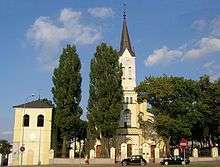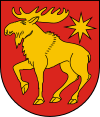Grajewo
| Grajewo | ||
|---|---|---|
 ul. Piłsudskiego in Grajewo | ||
| ||
 Grajewo | ||
| Coordinates: 53°39′N 22°27′E / 53.650°N 22.450°E | ||
| Country |
| |
| Voivodeship | Podlaskie | |
| County | Grajewo County | |
| Gmina | Grajewo (urban gmina) | |
| Established | 15th century | |
| Town rights | 1540 | |
| Government | ||
| • Mayor | Dariusz Latarowski | |
| Area | ||
| • Total | 18.93 km2 (7.31 sq mi) | |
| Population (2016) | ||
| • Total | 21,499 | |
| • Density | 1,100/km2 (2,900/sq mi) | |
| Time zone | UTC+1 (CET) | |
| • Summer (DST) | UTC+2 (CEST) | |
| Postal code | 19-200 | |
| Area code(s) | +48 86 | |
| Car plates | BGR | |
| Website | http://www.grajewo.pl | |
Grajewo pronounced [ɡraˈjɛvɔ] is a town in north-eastern Poland with 21,499 inhabitants (2016). It is situated in the Podlaskie Voivodeship (since 1999); previously, it was in Łomża Voivodeship (1975–1998). It is the capital of Grajewo County.[1]
History

The first settlements in the region of modern Grajewo already existed in the early 15th century. The first documented mention is from the year 1426. In 1540 the town obtained municipal rights from Polish King Sigismund I the Old. Around 1800 the town had 23 houses and 218 inhabitants.
Partitions of Poland
After the Partitions of Poland by the neighbouring empires, in 1815 Grajewo became part of the Russian Congress Poland. In the second half of the 19 century, trade and handicrafts developed. Due to the participation of the population in the January Uprising against Tsarist Russia, the town lost its municipal rights in 1870. With the establishment of a rail link between the German city of Lyck and the then-Russian-controlled city of Białystok, the town’s development was accelerated.
A Jewish community existed in Grajewo from the late 18th century. At times, Jews formed a majority of the town population. In 1808, 197 Jews live in the town, 39% of the total population. In 1827 they made up a majority, with 57% of the population. In 1857 the percentage rose to 76% and in 1897 over 4,000 Jews lived in the town. Following the First World War, the Jewish population fell sharply. In 1921, 2,834 Jews lived in the town, 39% of the population.[2]
World war I
During the First World War a large part of the town was destroyed. Following the war, the town became part of the Polish Republic and was granted municipal rights again on July 4, 1919. Between the world wars, Grajewo was the seat of a district office and had around 9,500 inhabitants.
World war II
The Pre-war population of 9,500 included 3,000 Jews. The Germans occupied the town for three weeks from 6-7 September 1939. During the German occupation the synagogue and Bet Midrash were burned and 300 Jewish men were deported to a forced labor camp in East Prussia. The town was then handed over to the [Soviet Union]]. On 22 June 1941, during Operation Barbarossa, German border guards shelled the town and the occupied it, setting up a military command post in the town. Adult Jews were employed in forced labor by the Germans.[3] On 29 June 1941, following Sunday mass, local Polish anti-Semites carried out a pogrom killing 10 Jews and injuring dozens of others. Rumors circulated that the Poles received advance permission from the Germans, however most scholars believe this is not the case as the Germans halted the pogrom by shooting dead three of Polish perpetrators and took victims to a hospital.[3] However the next day on 30 June the Jews of the town were assembled at the market square by the German Gestapo and the Polish perpetrators (acting as auxiliary police) of the pogrom were asked to identify communists who were then brutally beaten. A similar incident took place on 3 July. 300 Jews, alleged communists, were arrested and placed in the old Synagogue. Following the German unit departing, these Jews were tortured by the Poles for the next four weeks. The Germans executed the survivors in August.[3][4]
According to survivor testimony only some 1,600 of the 3,000 Jews of the town survived in August, and they were placed in a ghetto.[3][4] On 2 November 1942 the SS surronded the ghetto, and drove out the Jewish inhabitants to a transit camp in the village of Bogusze. From there they were sent to Treblinka extermination camp and Auschwitz concentration camp and most of them were murdered on arrival.[3]
The Red Army marched into Grajewo on January 23, 1945. The war cost the lives of around 5,000 people in Grajewo and about 30% of the town was destroyed.
Points of interest
- Wooden houses from the 19th century
- Classicist chapel of Wilczewski family from 1839 at the cemetery
- Neo-Gothic church of the Holy Trinity from 1882
- Church belfry from 1837
- Tavern from mid 19th century
- Railway station from 1873
- Roadside chapels from mid 19th century
- Building of a local Secondary School from 1931
- The market square from the 18th century
Sports
- Warmia Grajewo - football club
Notable people from Grajewo
- Eliyahu-Moshe Ganhovsky - Israeli politician and religious Zionist activist
- Antoni Karwowski- painter and performance artist
- Elyah Lopian - prominent rabbi
- Maciej Makuszewski - Polish footballer
- Eliyahu Meridor - Israeli politician who served as a member of the Knesset
- Simon Rawidowicz - American Jewish philosopher
- Andrzej Szczytko - Polish film director and actor
| Wikimedia Commons has media related to Grajewo. |
Notes and references
- ↑ Grajewo: Official website. General information. (Polish, with Google translate).
- ↑ Grajewo Memorial Book Yizkor Project (Yiddish & English).
- 1 2 3 4 5 The United States Holocaust Memorial Museum ENCYCLOPEDIA OF CAMPS AND GHETTOS, 1933–1945, Geoffrey P. Megargee, Martin Dean, and Mel Hecker, Volume II, part A, page 887-889.
- 1 2 Bender, Sara (2013). "Not Only in Jedwabne: Accounts of the Annihilation of the Jewish Shtetlach in North-eastern Poland in the Summer of 1941". Holocaust Studies. 19 (1): 1–38.
- Grajewska Plotka (Polish)
- grajewo24.pl (Polish)
- e-grajewo.pl (Polish)
- Zapasy Grajewo (Polish)
- Ogłoszenia Grajewo (Polish)
- This article incorporates text from the German Wikipedia article Grajewo.


